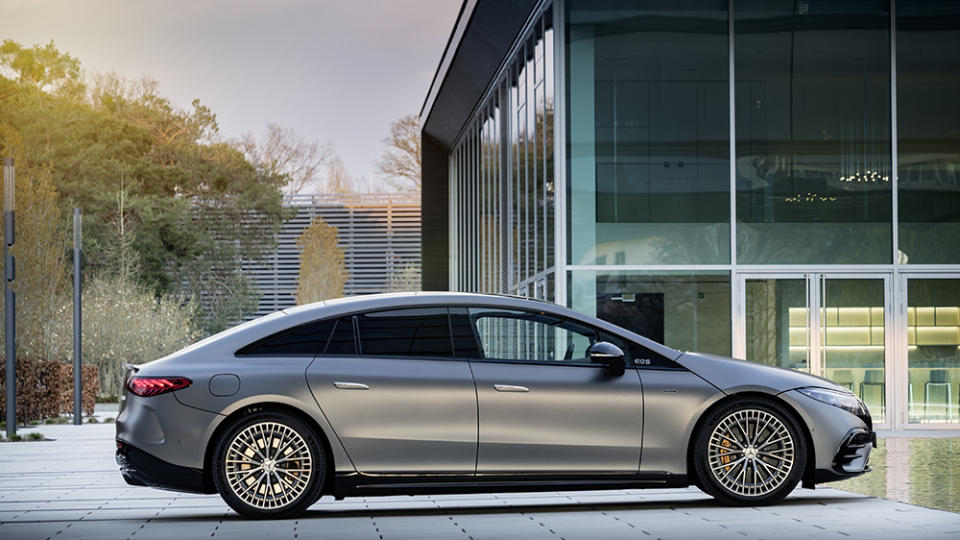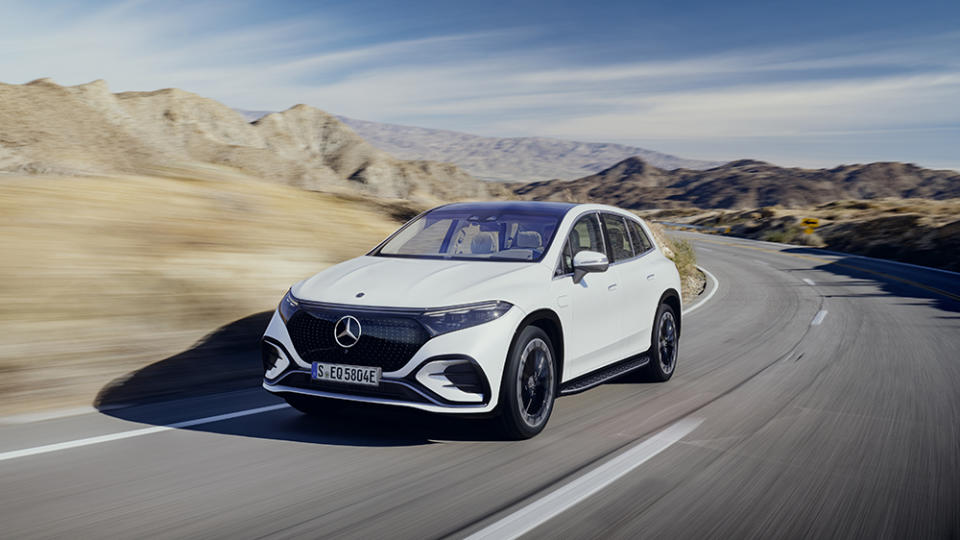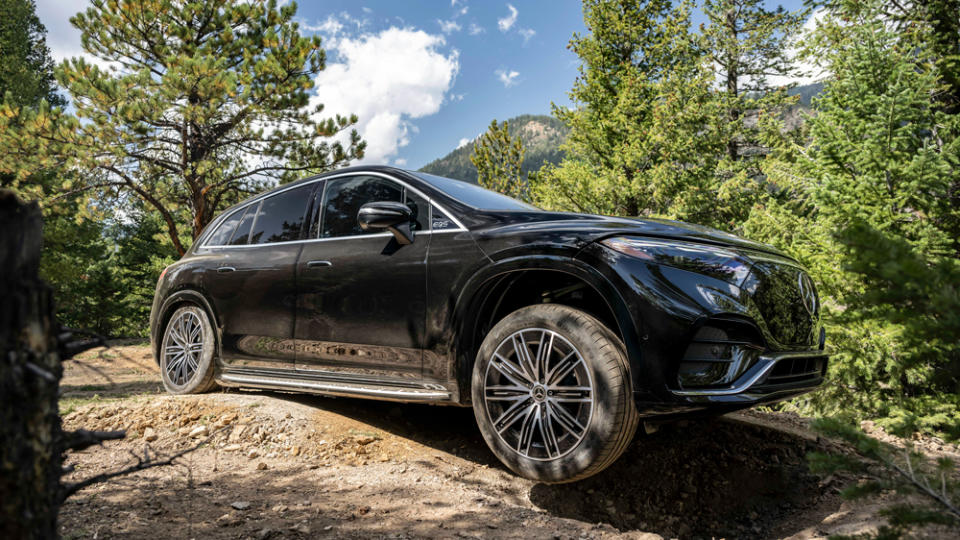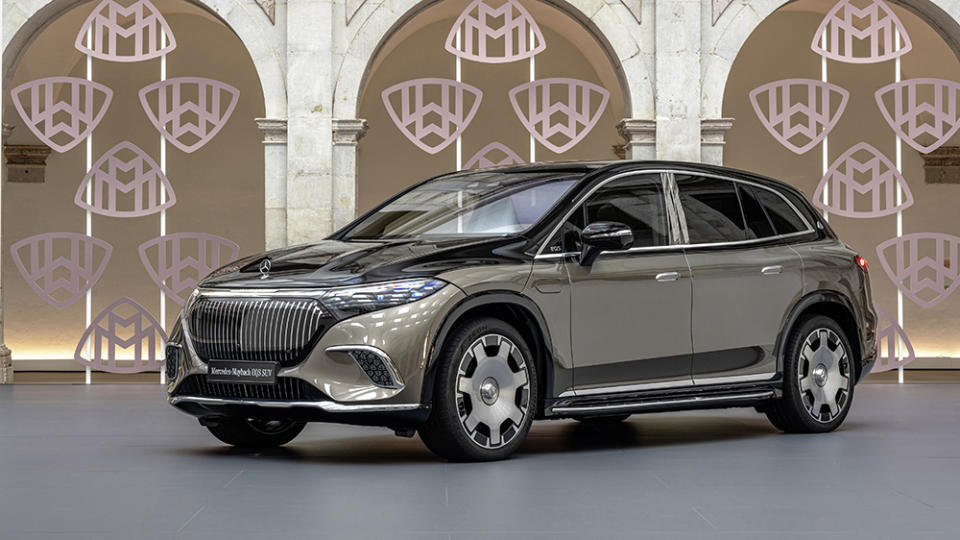The 2024 Mercedes-Benz EQS: Everything We Know About the All-Electric Luxury Sedan and SUV

Overview
It may come as a surprise that Mercedes, renowned for its prowess with internal-combustion engines, had its name on an electric vehicle as far back as 1906, more than a century before Tesla burst onto the scene. Times have changed and the marque launched the Mercedes EQ line of battery-powered cars and an SUV late last decade—which is led by the EQS.
As the name may have given away, the EQS is the automaker’s fully electric take on its longtime flagship, the S-Class sedan. The car is more than just a zero-emissions version of the venerable saloon, though. Debuting just one year after the introduction of the four-door’s latest generation, it’s a complete reimagining of the car, packed with advanced tech inside and out. It’s also available as an SUV.
More from Robb Report
Hyundai's Bonkers N Vision 74 Concept Will Go Into Production: Report
Americans Expect EVs to Have a Significantly Longer Range Than Drivers in Other Countries
Tesla may have had near-complete dominance of the EV sector at the start of the decade, but three years later its market share has shrunk dramatically. Excellent battery-powered models like the EQS from legacy automakers are a big part of the reason why. Read on to find out everything you need to know about Mercedes’s first series-production electric flagship.

Engine, Power and Performance
Any conversation about the EQS needs to begin with its all-electric power train. Actually, its three power trains, one for each model that is currently available—the EQS 450+, the EQS 450 4MATIC and the EQS 580 4MATIC. The first sedan has a single-motor setup and rear-wheel drive, the second has two motors and all-wheel drive and the third has a more powerful duo of motors that send power to all four wheels.
Unsurprisingly, there’s a pretty vast difference between the capabilities of the different configurations. Just be assured that the entry-level EQS 450+ is no slouch. The single-motor version produces 329 hp and 406 ft lbs of torque. The EQS 450 4MATIC adds a motor and bumps up output to 355 hp and 590 ft lbs of torque. Most powerful of all, though, is the EQS 580 4MATIC. The two motors combine to produce an impressive 516 horses and 611 ft lbs of twist.

Those are more than solid performance specs, but they do pale in comparison to the Lucid Air and Tesla Model S Plaid, both of which deliver over 1,000 hp, a figure that used to be only attainable by the most extreme supercars. Still, the EQS 450+ can accelerate from zero to 60 mph in 5.5 second, the EQS 450 4MATIC in 5.3 seconds and the EQS 580 4MATIC in just 4.1 seconds. Whichever model you choose, you can expect a top speed in excess of 130 mph. For most drivers, especially those who mainly use their cars to commute and drive around town, that’s more than enough power.
Battery Range and Charging
When the EQS debuted in 2021, the car was expected to offer a range in excess of 400 miles (indeed, that’s what we were told specifically on our last test drive). In the end, neither of the launch models, the EQS 450+ and EQS 580 4MATIC could deliver on that promise, with the single-motor EV receiving a range rating of just 350 miles from the EPA, while its more powerful counterpart was rated for 340 miles. The EQS 450 4MATIC, which was introduced the next year, was also rated for 340 miles. Those figures, of course, aren’t bad. In fact, all three versions of the battery-powered sedan are among the longest-range EVs currently on the market. But Mercedes set high expectations for its EV, so it was both surprising and disappointing that it couldn’t quite deliver.

The EQS’s impressive range comes courtesy of the 108.4 kWh lithium-ion battery pack that’s standard across the lineup. The EV is also compatible with DC fast charger, allowing you to go from 10- to 80-percent capacity in just 35 minutes. If you don’t have a fast charger at home, it’ll take just over 11 hours to fully replenish the battery. That’s not exactly expedient, but if you’re using the car mostly for commuting, chances are you’ll rarely go below the 50 percent mark, so your daily charge will take much less time. Think of it like plugging in your smartphone before going to bed and waking with 100 percent battery capacity.
Exterior and Design
If the EQS was just a new S-Class with an electric power train, it would be a striking car. But Mercedes realized that if its flagship EV was going to stand on its own, it needed its own distinct look. The two sedans certainly look like they belong to the same family, but the EQS has more in common with the Vision EQS concept from 2019. While not as futuristic as the dreamy prototype, it shares a similar wide-set stance and curvilinear shape, with sweeping lines traveling from front to back in an attempt to make the car as aerodynamic as possible. In fact, it’s currently the world’s most aerodynamic series-production car, with a drag coefficient of just 0.20.
The biggest change is up front, though. With no combustion engine to cool, the S-Class’s traditional vented grille has been replaced with a gloss black panel sporting the brand’s iconic star logo in its center surrounded by a field of smaller three-pointed stars. It’s topped by a continuous LED band that connects the two Digital Light smart headlamps. In addition to providing front-end lighting, this panel also houses a number of cameras and sensors, including radar and lidar. The hatch-like rear, which has led some to call the four-door a liftback, is adorned with a similar lighting motif. Overall, the EQS may look slightly less stately than the S-Class, but its lines are decidedly more modern.
Interior, Infotainment and Connectivity

The EQS really comes into its own when you open up the doors. The sedan has a thoroughly futuristic interior that’s basically unmatched by anything else on the market, even the Tesla Model S and Lucid Air. The front seats look like the cockpit of a spaceship, especially if you opt for the dashboard-spanning MBUX Hyperscreen infotainment system (more on that in a bit). Designers also took advantage of the sedan’s 126.4-inch wheelbase to make the rear as roomy as possible. The back bench has space for three passengers, or two if you opt for a center console. High-quality materials—like quilted leather covering the seats—abound throughout the cabin. There are also a number of wellness features, like a HEPA filtration system, massaging seats, ambient lighting and in-cabin soundscapes meant to calm and soothe.

The interior’s most striking feature is the 56-inch Hyperscreen. The massive infotainment touchscreen stretches across the whole width of the car and offers up a staggering 377 square inches of visual space, broken up only by integrated air vents. It comprises three displays seamlessly blended together via OLED technology: one for the driver, one in the traditional infotainment position and another solely for the front passenger should they get tired of gazing at the open road.
The 12.3-inch driver’s display acts as a digital gauge cluster from which you can monitor the car and journey. The 17-inch infotainment and 12.3-inch passenger displays allow you and your passengers to select entertainment options, check out your route and adjust the climate control settings. These same options, along with Android Auto and Apple CarPlay compatibility, are also accessible via a standard 12.8-inch infotainment screen if you opt against the Hyperscreen, but what’s the fun in that?
A High-Performance Option

As hard as it may be to believe, there are some drivers who don’t feel that 516 horses are nearly enough. Luckily for them, Mercedes’s performance division, AMG, would seem to agree. That’s why the sub-brand released its own version of the EQS last year.
With the exception of a few visual cues—the Panamerica-style “grille,” deck lid spoiler and aggressive forged rims—the AMG EQS looks just like the standard version of the EV. Spend some time behind the wheel, though, and you’ll feel the difference. That’s because its dual-motor powertrain, which is similar to that found in the EQS 580 4MATIC, can generate a maximum of 751 horses and 752 ft lbs of torque (both significant improvements over the non-AMG model). It may still not be a match for the Model S Plaid and Lucid Air, but it’s got enough boost to get you from zero to 60 mph in just 3.4 seconds. It also comes with Mercedes’ Ride Control+ suspension setup so that high-speed acceleration still feels silky smooth.
All that extra grunt doesn’t come cheap. The AMG EQS isn’t necessarily expensive by the performance division’s standards, but it does cost nearly 50 percent more than the standard version of the EV. We have a feeling there are a number of speed-obsessed Mercedes enthusiasts who won’t mind one bit.
A Trio of EQSs for SUV Lovers, Too

An all-electric powertrain isn’t the only thing the EQS can claim over its gas-powered counterpart. It’s also available, since last year, as an SUV. The two vehicles share a definite visual style, but the EQS SUV, unsurprisingly, is taller. Its roof also extends all the way to the rear door, as opposed to tapering into the rear end as it does on the sedan. The biggest difference, though, can be found inside the vehicle. The extra height results in an even more spacious cabin. There’s even room for an optional third row of seats if you want to be able to drive with up to six others.
As with the sedan, there are three powertrain options for the EQS SUV. Both the rear-wheel-drive EQS 450+ SUV and the all-wheel-drive EQS 450 4MATIC SUV deliver 355 hp. The latter’s powertrain has two motors that combine to output 590 ft lbs of torque, as opposed to 419 ft lbs of torque. The top-of-the-line EQS 580 4MATIC SUV, meanwhile, has a dual-motor setup that generates a total of 536 hp and 633 ft lbs of torque. Each version comes with a 108.4 kWh battery pack, just like the sedan, with ranges varying from 285 to 305 miles. The trio also comes equipped with an adaptive air suspension and have “Off Road” drive mode for anyone to brave enough to venture away from the pavement.
First Drive Impressions

Robb Report has gotten to spend some time with each version of the EQS released during the model’s first two years on the market. In the fall of 2021, writer Basem Wasef came away from his time with the EQS sedan impressed by Mercedes’s ability to imbue the EV with genuine gravitas. “The EQS evokes a feeling of well-crafted, old-world solidity despite its unrepentant digitization, which includes a 12.3-inch virtual instrument panel, a 12.8-inch central display and an available Hyperscreen, which adds a customizable touchscreen display ahead of the front passenger,” he wrote. Months later, in February 2022, Wasef drove the AMG EQS and felt it was an even “more compelling car.” That fall, Alexandra Cheney got behind the wheel of the EQS SUV, and found that it was more than capable of conquering all the challenges presented by “rut-filled” dirt roads 30 minutes west of Denver. “Although most owners of the new Mercedes-Benz EQS SUV will opt out of taking their fully electric, full-size vehicle off-roading, that’s beside the point,” she wrote.
What’s New for 2024
Mercedes lovers may have noticed there hasn’t been any mention of Maybach prior to now. That’s because the luxury sub-brand’s take on the EV—and its first battery-powered model period—won’t launch until the upcoming 2024 model year. The EQS sedan and SUVs is very clearly a luxury EV, but just wait until you see the Maybach EQS 680 SUV. A host of elegant new exterior details—like a three-pointed star hood ornament, Panamerica grille and monoblock wheels—and an even more sumptuous interior mean this SUV is about as decadent a battery-powered vehicle you’ll find outside the Rolls-Royce Spectre. It also shares a dual-motor powertrain with the AMG EQS sedan, meaning it can generate 649 horses and 700 ft pounds of twist. It also has a 372-mile range, easily besting the rest of it the EQS sedan and SUV lineup.

Pricing: Is Mercedes’s Electric Flagship Worth It?
It’s should be clear by now that the EQS, both the sedan and SUV versions, is one of the best EVs currently on the market. It doesn’t matter what model you choose, they all mix luxury comforts, state-of-the-art features and exhilarating performance to an impressive degree. Battery-powered excellence doesn’t come cheap—but it also might not cost as much as you expect. Both the entry-level sedan and base SUV start at $104,400, which is more than $10,000 less than the gas-powered S-Class. The two top-of-the-line EQS 580 4MATICs, meanwhile, runs $125,990. The AMG EQS (which $147,550) and upcoming Maybach EQS (which will reportedly cost $200,000) are pricier, but as Mercedes fans know, that’s only to be expected.
More stories about the Mercedes-Benz EQS from Robb Report:
Here’s How Much Mercedes-AMG’s High-Performance EQS EV Will Cost
Mercedes-Benz Expands Its EQS Line With a New All-Electric SUV
Mercedes-Maybach Just Unveiled Its First All-Electric Model, the Ultra-Luxe EQS 680 SUV
Best of Robb Report
Sign up for Robb Report's Newsletter. For the latest news, follow us on Facebook, Twitter, and Instagram.

